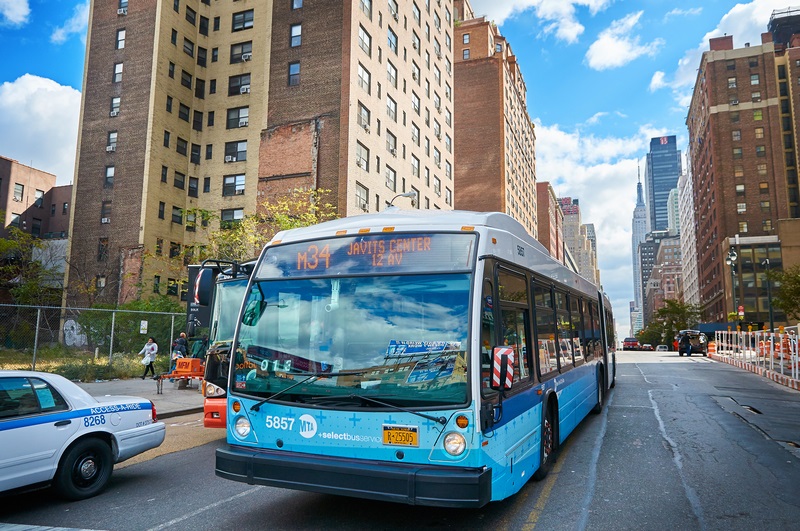
Bus rapid transit (BRT) is gaining an increasingly high profile in the US public transport agenda, for two main reasons. One is the potential for ‘trains on wheels’ to save substantially on installation costs as compared with other modes such as underground metros or light-rail transit.
Another, highlighted in the case of New York City, is the value of having a rapid surface-based alternative available when its subway (metro) rail tunnels flooded, as they were by Superstorm Sandy in 2012.
Hence the inclusion of plans for a major BRT network in the recommendations of the New York 2100 Commission, set up in November 2012 by New York State Governor Andrew Cuomo in response to a string of severe weather events, culminating in Sandy. During that crisis, the city’s
As a (later successful) candidate for the mayoralty of New York City in 2013, Bill de Blasio promised to create a “world-class” BRT system of at least 20 routes. A year later, a pressure group of advocates mustered under the banner of ‘BRT for NYC’ to keep him on track.
They are stressing that BRT would add a very useful supplement to the city’s existing surface transit capability, with average speeds of the existing bus services among the lowest in the country. Further, it would extend public transit to outlying residential and employment centres that lie beyond the reach of the current subway network, taking advantage of the existing roadway and bridge infrastructure and equipping this with appropriate ITS technologies.
Characteristics of Bogotá’s BRT
• Dedicated exclusive median lanes
• Stations with level boarding to buses
• Off-board ticketing
• Bespoke vehicles (articulated, high floors with multiple doors and low emissions)
• ITS-supported centralised control and dispatch, passenger information and electronic ticketing
• A well-defined brand The campaigners have two more policy thrusts. One is based on social equity, stressing the need for cheaper, as well as better, public transport for low-earning commuters, with better outer orbital connections across the radial subway network.
The other is based on safety concerns, with the identification of one potential route, the Woodhaven/Cross Bay corridor in the borough of Queens, which has five dangerous intersections. Its record is of 1,243 people injured – and eight dead - in bus and car crashes over a 2.5-year period from July 2012 to December 2014. It also has up to 10 – currently heavily congested - traffic lanes, allowing scope for the necessary reconfiguration of road space.
BRT for NYC has already notched up one success. In 2015, the New York City Department of Transportation (NYC DOT) unveiled a plan for a limited-stop Select Bus Service (SBS) along the corridor, with connections to subway stations en-route.
SBS is seen as a ‘BRT-lite’ system, with typical off-board fare collection instead of on-board MetroCard swiping, and transit-signal priority; but with dedicated, rather than physically segregated lanes (though NYC DOT commissioner Polly Trottenberg has not ruled out these for the corridor). But it has proved itself elsewhere in the city to be an effective user of transit funds, generating increases in ridership of up to 10% and decreases in travel times of up to 23% compared with the existing bus services.
US cities with existing systems, or ones under development, include San Diego and Los Angeles, both in California. In the former, a new South Bay rapid transit corridor is due to start running in 2018 on a 34km route ending at an international transit centre at Otay Mesa, on the border with Mexico. It combines a 9km core of in-median dedicated transitway with sections using existing high occupancy vehicle lanes. It is being funded through TransNet, a regional, voter-approved $0.5 cent sales tax for local transportation projects.
In Los Angeles, the LA County Metropolitan Transportation Authority is due to complete studies for two new BRT corridors by autumn 2016.
But the US has a way to go before it can match the extent of deployment already evident in the southern part of the American continent. As a new and well-researched publication, Restructuring public transport through Bus Rapid Transit makes clear, the concept of BRT has strong Latin American roots.
Pioneered in 1974 in Curitiba, Brazil, where it promptly drew worldwide attention, the approach became widely replicated. In 2000, the Colombian capital, Bogotá, introduced its TransMilenio system with what the publication calls ‘operational innovations that … may be considered the tipping point for the introduction of BRT corridors around the world’.
TransMilenio continues to attract attention from advocates of the concept from the US and more widely. Former Bogotá official Dr Dario Hidalgo, a contributor to the publication cited above, told ITS International: “Bogotá’s is a very high capacity bus system, with very high ridership levels. It combines all the elements of a ‘full’ BRT System.” (See box).
It currently carries 2.2 million passengers per day, with a peak load of 48,000 passengers per hour (said to be among the highest in the world), along 113km of in-median lanes. In 2012, it was integrated, along with conventional buses, into a new public transport system, SITP, which operates a single electronic fare-card.
TransMilenio users have access to real-time travel information at stations and via apps. There is also wider modal integration and a number of the BRT stations are equipped with cycle parking to connect with the city’s nearly-400km of bikeways.
Hidalgo is now director, integrated transport of the Embarq Network at the Washington, US-based World Resources Institute Ross Centre for Sustainable Cities. “What is very special in Bogotá,” he says, “is that the stations are very long (serving three buses simultaneously) and that there are overtaking lanes. These features are probably not a must in most corridors, but the others [see panel] provide the opportunity for a fast, reliable and convenient service.”
Specifically in relation to the US, he acknowledges that transit corridors there will not require as much capacity. “Nevertheless, the elements deployed in Bogotá can be scaled to their needs.”
But there is a debit side. The system started with a very high degree (80%-plus) of public acceptance, but this has fallen in response to high occupancy levels, lack of adequate maintenance and delays in plans for expansion. These factors have sparked a fierce debate over rival technologies, with failures in BRT operation being cited by the proponents of a new metro system, which is currently in the planning stage.
But recently elected Mayor Enrique Peñalosa (who was earlier in office when TransMilenio began, and was a member of the 2014 New York MTA Reinvention Commission) has pledged wide-ranging improvements. In his inaugural address on at the start of this year, he committed himself to making Bogotá “a world leader in sustainable mobility with the best public transport system in Latin America by 2020.”
Achieving this would strip the crown from the current title holder, Santiago de Chile, as ranked by the International Association of Public Transport (UITP).
Declaring himself “an optimist”, in an article published in January 2016 in the Colombian newspaper El Tiempo, Hidalgo writes that the mayor, and the others in charge of the proposed transformation “are technically minded people who are in love with the city and committed to its improvement.”
But Peñalosa will have his work cut out - not least for financial reasons, with the city needing sums well above its current resources, which include a national government contribution. He wants to impose access charges for cars - a suggestion that the city council has previously rejected more than once - as the “only fair solution”.
But a possible model exists, as presented by global consultants Steer Davies Gleave at the 2014 ‘Model City’ International User Conference staged by transport software developers INRO. If the mayor succeeds, he may be in a position to claim the credit for delivering a second tipping point in the history of BRT.
Footnote: Restructuring public transport through Bus Rapid Transit is published by Policy Press, %$Linker:
About the Author: David Crawford has spent 20 years writing about and researching ITS and is a Contributing Editor to ITS International.











